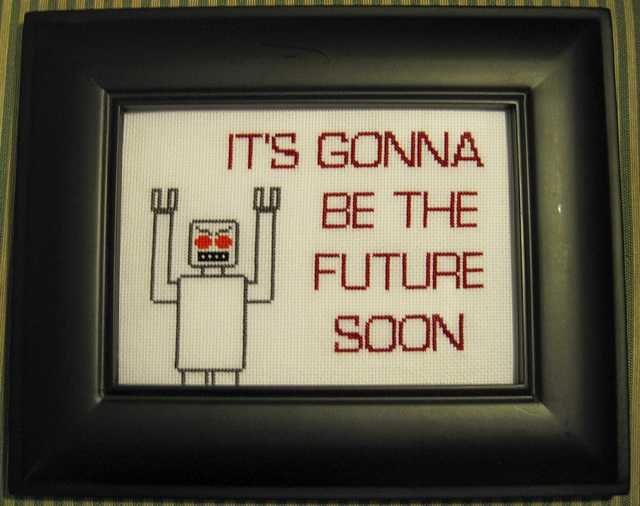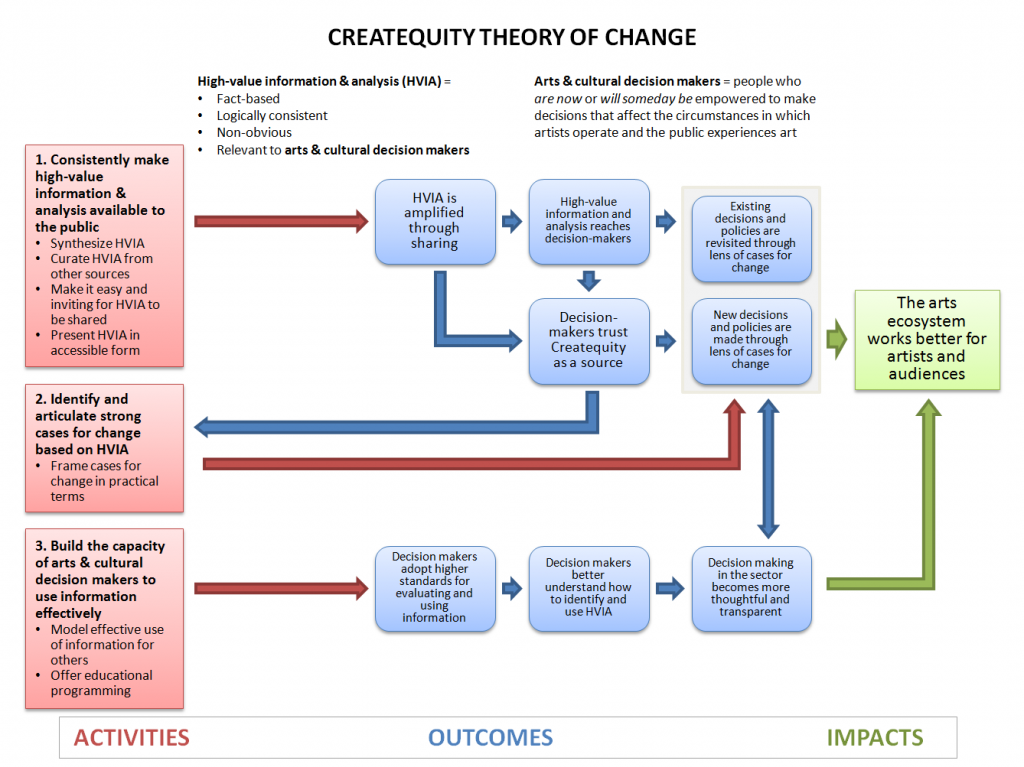|
TOO LONG; DIDN’T READ?
|
A Case for Change
Back in March, I co-hosted a Createquity Office Hours gathering for our editors, writers, and readers located in the San Francisco Bay Area. Among the attendees was a woman who wanted us to review a research report her organization had recently published. Createquity’s only real channel for such reviews at the moment is the Arts Policy Library, a format involving an exhaustive deconstruction of seemingly every strength and weakness of a research text. Because they are so labor-intensive to generate, we made a decision years ago to focus Arts Policy Library articles only on high-profile publications – which means that up until now, the way to get Createquity to review a research report has been to get lots of other people talking about it first. As I rattled off a few names of other outlets to whom this woman could pitch her study, I found myself admitting rather apologetically: “the thing is, Createquity is not a tastemaker when it comes to arts research. We don’t drive the conversation, we react to it.”
As I heard those words coming out of my mouth, all I could think to myself was, “Jesus, how lame is that?” If Createquity was not going to be a tastemaker for arts research, of all things, then who was? But as I thought about it more, I realized this observation wasn’t just true for research reports. Our recurring features like Around the Horn and public arts funding updates are necessarily reactive to events in the news. When we do a feature in response to a topic proposal from a guest author or Fellow, we’re reacting to that individual’s interest and expertise. Sure, we have a strong editorial filter, but as I reflected, I came to realize that we hardly exercise any editorial direction at all.
But maybe we should be. Createquity and I have come a long way since the days when I was a fresh-faced grad student with a crazy idea to start a blog about the arts in a creative society, eager to soak up as much information as I could about the field. Back then, blogs were still something of a novelty, and few writers and outlets were trying to draw connections across disciplines and comment on the “behind the scenes” elements of arts management, funding, research, and policy in a broader way. But as this personal blog chronicling my journey through business school has evolved into a multi-author, fieldwide resource read by thousands, a lot has changed alongside it. Social media has become the premier way to engage in discussion online and is changing our reading habits in substantive ways. Arts institutions have created dozens of venues for discussion and debate in the interest of advancing open-ended conversations about the future of our field. More and more, I hear from our readers that that they are simply too busy to keep up with it all. Whereas the problem in 2007 was not enough information, the problem today is that there is too much.
All of this has resulted in a resource that, after seven years, is no longer optimally serving its readership. Don’t get me wrong: I’m incredibly proud of what Createquity has accomplished, and continue to believe that we offer a quality of commentary and depth of insight that is unparalleled in our field. But whereas the crucial opportunity of 2007 was to expand access to conversations about the future of the arts to people who hadn’t traditionally been able to partake in them, the crucial opportunity of 2014 is to start bringing those conversations in for a landing. We’ve collectively learned enough about the way that the arts sector works, what kinds of challenges it faces, and what kinds of interventions are possible that we can begin to make the kinds of principled, evidence-backed recommendations that we can confidently stand behind. So why aren’t we putting actionable next steps in front of people who could conceivably make a difference?
A Theory of Change
Last winter, Createquity’s editorial team gathered in Philadelphia to discuss our strategic goals and the evolution of the site. To frame the discussion, we generated what’s called a theory of change, which is a way of depicting a strategy visually. I’ve now been a part of many theory of change development processes, and the capacity of this tool to open up new ways of seeing one’s role in the world never ceases to impress me. Our own exploration was no exception.
At Createquity, we’ve always placed great importance on quality: of prose, presentation, and analysis. We take pride in our ability to come up with insights that are not obvious and convey them with style. We also try to take an open-minded, objective approach – which is not to say that we never have an opinion, but rather that we adjust our opinions in light of the facts instead of looking for facts to justify our opinions.
These values have built our reputation thus far, and we’ve had the privilege of publishing some truly fantastic articles over the years. But as we fleshed out our theory of change, we realized that publishing articles is not really the point for us. Looking back on what we’ve done to date, the articles I’m proudest of are the ones that actually made a difference in the way that people in power approach their work – most notably the series on creative placemaking and research that began with 2012’s “Creative Placemaking Has an Outcomes Problem.” We want Createquity to be not just interesting but useful – in other words, we want to have an impact.
Ensuring a consistent and direct connection between our work and potential decisions on behalf of the sector requires us to engage in advocacy in a much more proactive fashion than we ever have before. And so, beginning this fall, that’s exactly what we’re going to do.
Being the Change
Take another look at the diagram above and you’ll see a key activity for Createquity that is brand new: “Identify and articulate strong cases for change.” What will these cases for change be, exactly? Well, the truth is that we’re going to need to invest a little time towards figuring that out – after all, we’d prefer not to come out with guns a-blazing on behalf of some cause that we later decide wasn’t such a great idea in retrospect. But we have a pretty clear sense of how we’re going to go about it, at least. Createquity’s ultimate goal is to help the arts ecosystem “work better for artists and audiences.” So, what does that look like in practice? What are the characteristics of a healthy arts ecosystem versus an unhealthy one? Put another way, if everything were perfect, how would that be different from how things are today? Our next step is to map out answers to these questions in enough detail that we can start to see the picture as a whole instead of in little bits and pieces. In identifying the gaps between our perfect world and present-day reality, we’ll start to get a sense of where the biggest priorities are, and which of them are not getting enough attention. Once we know which areas we want to focus on, we’ll devote ourselves to researching the state of the evidence in those areas, with particular attention to “what works”: what kinds of interventions and next steps might conceivably move the needle on the things that we think matter most?
This new approach will require a near-total restructuring of our editorial process. Right now, we spend a lot of time (somewhere between 15 and 20 hours a week) assembling links from widely-read sources for regular columns like Around the Horn and the Public Arts Funding Update. Our other major editorial focus, the Createquity Fellowship, has produced some great content (and people) over the past three and a half years, but invariably our team spends so much time editing and mentoring that we hardly have any left over for writing. Imagine if we spent all of that time instead reading all those research articles and publications that hardly anyone else is paying attention to, but arguably have more to teach us? And then synthesizing what we’ve learned so we can point out the areas that badly need more of our collective attention?
For all those reasons and more, we’ve decided to reinvent Createquity from the ground up to support our new vision. When you return to this address in the fall, things are going to look very different around here! As exciting as this is, as you can probably tell, it’s going to take a ton of work. So we’ve decided not to post any new content to Createquity this summer to enable us to focus our undivided attention on preparations for the relaunch. If you just can’t imagine not getting your Createquity fix, we’re taking this opportunity to stroll through our back catalogue and repost some of our favorites. For those of you who have been with us from the beginning, you might be surprised at how fresh some of those old chestnuts still are.
Finally, if you’re as psyched about this new direction as we are and would like to get involved, there are lots of ways to do so!
- Spread the word: In its new incarnation, Createquity’s success is highly dependent on reaching the right people. If all goes according to plan, we’re going to be putting out some pretty important, compelling stuff in the fall and beyond – better than anything you’ve seen here before. By sharing what you read, you’ll be doing your colleagues a solid.
- Get into the weeds with us: If you’re not sure you trust us to make the right decisions about which of the arts ecosystem’s problems are most important, or what the research tells us about what we could do to fix them, I don’t blame you. We’re just a few people, after all. That’s why, when Createquity relaunches, the considerations and logic behind all of our major editorial decisions will be accessible via the website – often before any actual cases for change are generated. And if you want to get in there and debate us on the details, I guarantee we’ll listen to you. This is your chance to help steer us in the right direction.
- Help us pay for this thing: Createquity has been from day one an all-volunteer effort – we don’t even have a bank account. But this new website isn’t going to drop out of the sky for free, and we need to get our geographically dispersed editorial team together in one place for some in-person planning sessions, among other priorities. We’ve set up a crowdfunding campaign on Indiegogo and would love to have your support – and we have some cool/valuable perks to offer in return. Please consider donating today – it will go a long way towards making our new vision a reality!
- Join the team: We love working with smart, awesome people! As part of the new plan, the Createquity Fellowship will be evolving into an explicit apprenticeship for joining the editorial team. We also expect to have ad hoc volunteer opportunities available. Stay tuned for further details as the coming months unfold.
Until soon!

